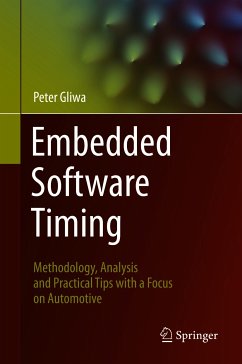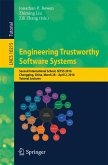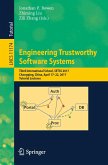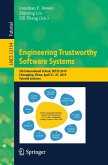Without correct timing, there is no safe and reliable embedded software. This book shows how to consider timing early in the development process for embedded systems, how to solve acute timing problems, how to perform timing optimization, and how to address the aspect of timing verification.
The book is organized in twelve chapters. The first three cover various basics of microprocessor technologies and the operating systems used therein. The next four chapters cover timing problems both in theory and practice, covering also various timing analysis techniques as well as special issues like multi- and many-core timing. Chapter 8 deals with aspects of timing optimization, followed by chapter 9 that highlights various methodological issues of the actual development process. Chapter 10 presents timing analysis in AUTOSAR in detail, while chapter 11 focuses on safety aspects and timing verification. Finally, chapter 12 provides an outlook on upcoming and future developments in software timing.
The number of embedded systems that we encounter in everyday life is growing steadily. At the same time, the complexity of the software is constantly increasing. This book is mainly written for software developers and project leaders in industry. It is enriched by many practical examples mostly from the automotive domain, yet the vast majority of the book is relevant for any embedded software project. This way it is also well-suited as a textbook for academic courses with a strong practical emphasis, e.g. at applied sciences universities.
Features and Benefits
* Shows how to consider timing in the development process for embedded systems, how to solve timing problems, and how to address timing verification
* Enriched by many practical examples mostly from the automotive domain
* Mainly written for software developers and project leaders in industry
The number of embedded systems that we encounter in everyday life is growing steadily. At the same time, the complexity of the software is constantly increasing. This book is mainly written for software developers and project leaders in industry. It is enriched by many practical examples mostly from the automotive domain, yet the vast majority of the book is relevant for any embedded software project. This way it is also well-suited as a textbook for academic courses with a strong practical emphasis, e.g. at applied sciences universities.
Features and Benefits
* Shows how to consider timing in the development process for embedded systems, how to solve timing problems, and how to address timing verification
* Enriched by many practical examples mostly from the automotive domain
* Mainly written for software developers and project leaders in industry
Dieser Download kann aus rechtlichen Gründen nur mit Rechnungsadresse in A, B, BG, CY, CZ, D, DK, EW, E, FIN, F, GR, HR, H, IRL, I, LT, L, LR, M, NL, PL, P, R, S, SLO, SK ausgeliefert werden.
Es gelten unsere Allgemeinen Geschäftsbedingungen: www.buecher.de/agb
Impressum
www.buecher.de ist ein Internetauftritt der buecher.de internetstores GmbH
Geschäftsführung: Monica Sawhney | Roland Kölbl | Günter Hilger
Sitz der Gesellschaft: Batheyer Straße 115 - 117, 58099 Hagen
Postanschrift: Bürgermeister-Wegele-Str. 12, 86167 Augsburg
Amtsgericht Hagen HRB 13257
Steuernummer: 321/5800/1497
USt-IdNr: DE450055826









